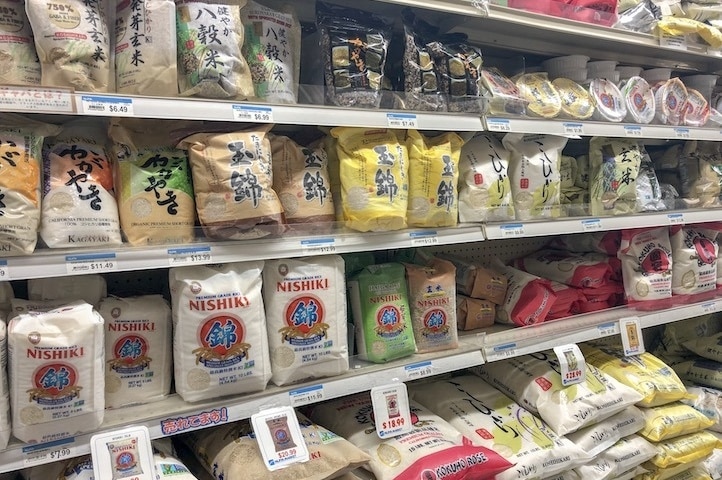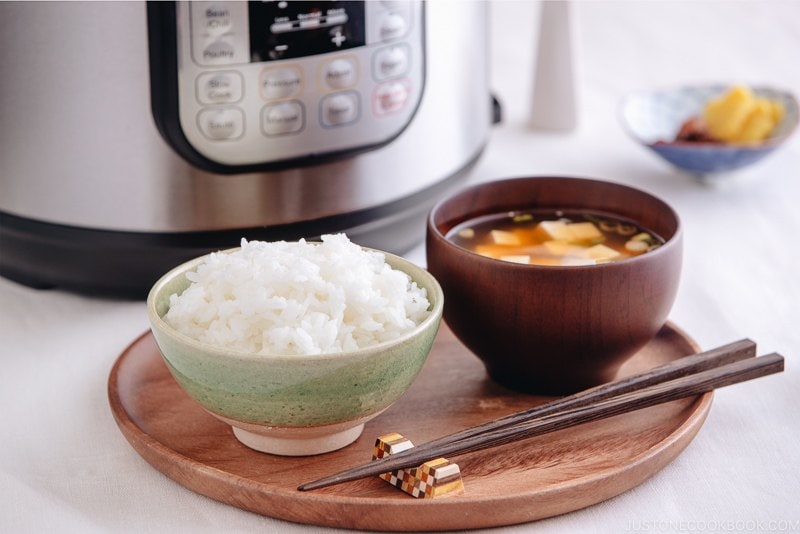
Is Japanese rice the same as sticky rice? What kind of rice is sushi rice? Is sushi rice the same as regular Japanese rice? It is not a surprise that there is a lot of confusion around types of rice and cooking rice. Today, we are going to address all of your frequently asked questions regarding rice in Japanese cuisine.
The significance of rice in Japanese culture cannot be overstated. It is the daily staple, a source of cultural identity, a driving force of the Japanese economy, and the fundamental element of Japanese cuisine. Whether you want to venture into Japanese cooking, or just want to make sushi for a party, the first steps are to learn the basics of rice.
Before we delve deeper, let’s take a quick look at the overall variety of rice out there.
Three Main Classifications of Rice
In general, the rice varieties can be classified into 3 groups – long-grain, medium-grain, and short-grain – based on their length-to-width ratio when cooked.
1. Long-grain rice
The grains of long-grain rice can be recognized immediately by its lengthy and cylindrical-shaped appearance. They are roughly 4-5 times as long as they are wide, and they are the most commonly used rice. When cooked, the rice stays fluffy yet firm, and the grains are separated and it is not sticky at all. Examples of long grains include Jasmine rice, Basmati rice, Mexican rice, traditional American long-grain white or brown rice, and European-grown style of rice.
2. Medium-grain rice
Medium-grain rice is usually about 2-3 times longer than it is wide. When cooked, the grains are tender, moist, slightly chewy and they tend to stick together a bit. Examples of medium-grain rice include Bomba rice (used in Paella), Arborio rice, and most of the Asian-style rice such as Chinese-style rice.
3. Short-grain rice
Short-grain rice is short and plump, and is only a tiny bit longer than it is wide. The rice grains cling together without being mushy when properly cooked. The grains have a higher starch content than regular rice.
It is also common where medium-and short-grain rice get combined into the same category, which can make for some confusion. Most of the Japanese rice belongs to the short-grain variety, although you can find medium-grain of Japonica rice being grown in California.
What is Japanese Rice?
What types of rice are used in Japanese cuisine? For Japanese cuisine, you can find 2 basic forms of rice that are prevalent and both are considered short grain cultivars of Japonica rice.
The first type of rice is uruchimai 粳米, known as the Japanese short grain rice or ordinary rice or Japanese rice in short. That’s the rice you use to make sushi, rice balls and in everyday Japanese dishes. It is also the type of rice being used to make sake and rice vinegar.
The second one is mochigome 餅米, also known as Japanese sweet rice or glutinous rice. It is commonly used to make mochi rice cakes or traditional wagashi sweets.
Although both the Japanese short grain rice and mochigome are characterized by their sticky texture, they are used differently and are not interchangeable. Mochigome is so much stickier, chewier and glutinous compared to the regular Japanese short grain rice.
To learn more about Japanese short grain rice, click here.
Is Japanese rice the same as sticky rice?
In the US and perhaps some other Western countries, you’d find Japanese rice have been referred to as ‘sticky rice’ by some people due to its sticky texture. Sometimes people also ask ‘how to make Japanese sticky rice’ when they are asking about making sushi rice.
Since ‘sticky rice’ does not have a definite meaning but more of a convenient term or casual name to describe a specific rice that is sticky, the usage gets muddled in different cultural contexts.
In the majority of Asian cultures, when we say sticky rice, it is typically referring to glutinous rice or sweet rice. So take note that while Japanese rice has a sticky quality compared to the other types of rice such as long grain Jasmine or Basmati rice, it is not the same as sticky rice.
To learn more about Japanese glutinous or sweet rice, click here.
What makes Japanese rice sticky?
Because of its high proportion of starch and moisture content, Japanese rice is characteristically clingy and sticky. Starch is itself composed of amylose and amylopectin. When the level of amylose is low and amylopectin is high, you get sticky rice. That’s the kind of rice grown in Japan. The unique stickiness of Japanese rice is what makes good sushi and defines the character of Japanese cuisine.
What about Sushi Rice? Is Sushi Rice the Same as Japanese Rice?
Sushi rice is steamed Japanese rice that is flavored with vinegar-based seasonings and it’s only used for making sushi. In Japan, it is known as sumeshi (vinegared rice).
The confusion occurs when ‘sushi rice’ being used as a label for regular Japanese short grain rice outside of Japan. Sometimes some recipes also refer Japanese rice as sushi rice.
In fact, the regular Japanese rice is commonly cooked plain for everyday meals, whether it is for Japanese curry, donburi rice bowls or to make onigiri rice balls. It is only when you are using the rice for sushi, you will then ‘sushi rice’ or sumeshi by seasoning the cooked Japanese rice with vinegar, salt, and sugar.
To learn how to cook the perfect sushi rice, click here.
What about Calrose rice? Is it considered Japanese rice?
Calrose rice refers to the medium grain rice that is grown in California. ”Cal’ as in a product of California, and ‘rose” indicates a medium grain rice. Developed by the Japanese-American in 1948, they have been used as a reasonably convenient and inexpensive rice of choice for many years in the US. They are not true Japanese rice, but they have a well-balanced flavor with moderate stickiness and are robust enough that most people and Japanese restaurants in the US use it for sushi and other Japanese dishes.
Can I use Jasmine rice for sushi? What about any other rice as the substitution for sushi?
If you wish for an authentic sushi, we do not recommend using jasmine rice as a substitute for sushi. Although we’ve heard from people who have no issue with the outcome of using Jasmine rice for sushi, it really doesn’t give you the right flavor and texture for making sushi. Not only Jasmine rice has a drier texture and different flavor, the grains don’t stick well together.
Since you can easily buy Japanese rice online or on Amazon these days, our best recommendation is to buy a small bag and use it for your sushi and any other regular meals like fried rice, rice bowls and various rice dishes. There is really no reason why you’d need to substitute Japanese rice with Jasmine rice or any other types of rice.
On Just One Cookbook, we have plenty of recipes using Japanese rice, so you don’t have to worry about not being able to use up a bag of rice if you don’t plan on making sushi that often.
Where Can I Buy Japanese Rice?
You can buy Japanese rice from Japanese or Asian grocery stores. Most of the major grocery stores like Walmart, Whole Foods, Target and local chains also carry some common brands which you can find in the Asian aisle. Alternatively, you can buy Japanese rice from online grocery stores or Amazon.
Which Brands of Japanese Rice Should I Buy?
There are many different brands of rice out there that can be used for Japanese cooking and for making sushi. In terms of quality, the Koshikikari variety is the most preferred Japanese rice and you can find various brands at Japanese grocery stores.
Here are some of our recommended brands of Japanese rice:
Shirakiku Rice, which is Koshihikari variety from California. Look out for the label ‘shinmai‘ 新米 or ‘new crop’ on the rice bags for the freshest crops.
Tamaki Gold (a California-grown Koshihikari) and Tamanishiki Super Premium Short Grain Rice (a hybrid of Koshikikari and Yuma Gokochi) are another two premium rice brands, but they can be also very expensive.
Some people also highly recommend Lundberg Family Farms Organic Sushi Rice (Japanese short grain rice).
For more affordable choices, you can try California-grown medium grain or hybrid variety that is widely available in the U.S. Botan Calrose, Nishiki, and Kokuho Rose are some of the standard brands out there. They may not be the best, but they are usually cheaper in price.
Japanese grocery store Nijiya Market sells Koshihikari rice from Toyama, Japan.
The judging criteria for the best Japanese rice usually include freshness, sweetness, shininess, and pleasant fragrance. You can give a few of the rice brands above a try. Once you learn how to cook them properly, you will be able to decide which rice you like most. And remember that good sushi is all about the rice. Use quality rice if you want good quality sushi.
Now that you’ve learned the basics of Japanese rice, it’s time to learn how to cook the rice properly. Don’t miss out our helpful tutorial posts below:
How to Cook Perfect Japanese Rice in a Rice Cooker
Click to learn how to cook perfect Japanese rice with rice cooker
How to Cook Perfect Japanese Rice on the Stove
Click to learn how to cook perfect Japanese rice over the stove
How to Make Perfect Sushi Rice
Click to learn how to make sushi rice
How to Store Cooked Rice
Click to learn how to store cooked rice
How to Cook Japanese Rice in an Instant Pot

Coming soon!
Did You Find This Article Helpful?
Do you have any favorite brands of Japanese rice that is not mentioned in the article? If you have more questions regarding Japanese rice or sushi rice, let us know in the comment section below.
Don’t want to miss a recipe? Sign up for the FREE Just One Cookbook newsletter delivered to your inbox! And stay in touch with me on Facebook, Pinterest, YouTube, and Instagram for all the latest updates.

Originally from Penang, Malaysia, Reese lives in Minnesota with her husband and their baby boy. She previously ran an Asian spice shop, and also worked on UNESCO Heritage projects in Penang in the areas of performing arts, history, and arts education. Reese loves spending time with her family, listening to podcasts, and reading up on art & design. And of course dreaming of another trip to Japan to hike mountain trails and eat her favorite street food Okonomiyaki. More from Reese →
from Merah Hati Cintaku https://ift.tt/2Fuesym
via MerahHatiCintaku.blogspot.com















